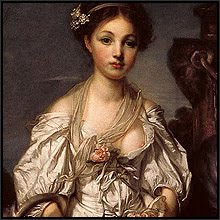In the ancient times before the Deluge, mysterious beings known only as the Watchers, the ‘sons of the gods’, looked down from the heavens on high, and seeing the comely ‘daughters of men’, descended to our world to party. The results of these unions were the Nephilim, human on their mothers’ side, and on their fathers’ side… well.. what, exactly? Quite a body of speculative literature has grown up around this brief but intriguing passage from the Book of Genesis. The Biblical explanation is that the Watchers were some kind of fallen (literally) angels, who during the long descent from their ethereal heights gradually acquired material bodies the closer to our world they came. For this and other passages the Book of Genesis can make for intriguing reading. And yet where it might be expected to expound upon significant details, the text instead yields only tantalizing glimpses, more shadows than substance. One is left with the feeling that there is more to tell, but that something, somewhere, is missing. And it is.

I have just completed reading the Book of Enoch. Enoch, the companionable prophet (my imagined portrait, above) who was the seventh generation from Adam. Enoch, whose lengthy description of his visit to the heavenly abode is among the finest and most stirring passages of visionary writing that I have come across. Enoch, who is the source for much detail that we feel is otherwise missing from Genesis. The identity of the serpent in Eden (and how it came to be there). A description of the actual fruit that hung on the tree of the knowledge of good and evil (it wasn’t an apple!) that grew in the Garden. The true cause of the Deluge (the brief reason given in Genesis, that it was ‘the wickedness of men’, always did sound to my ears like a not-very-adequate justification for pulling the plug on an entire planet). In short, it is the sympathetic voice of the prophet Enoch who supplies so much of the detail that seems to be lacking in Genesis.

The Book was known from a text written in Ancient Greek (above), but remained unread in the West until the Scottish traveller James Bruce returned from Ethiopia with a copy in the 18th century. This was later translated into English by Richard Laurence, and further existence of the original version, written in Aramaic (below) was confirmed when fragments were discovered among the Dead Sea scrolls in 1947.

So where is Enoch? Or rather: where is Enoch’s Book? Because (except, curiously, in Ethiopia) it failed to make it into the Biblical canon. The reason, apparently, was that the Church fathers considered aspects of the Book to be heretical, particularly the key question of immaterial angels being able to take on material bodies. And so Enoch hit the cutting room floor. Which I for one consider a tragedy of editing, not just because of the information that without it remains puzzlingly uncertain, but also because the book contains such fine passages of visionary writing.
And the Nephilim? Because Enoch certainly provides us with more information about them than their brief mention in Genesis. Well, another time, perhaps.

.
Artist: Hawkwood
Work: The Prophet Enoch, 2009
Medium: Digital painting with photographic elements
Location: Cyberspace
Sources:
'Fallen Angels and the Origins of Evil', by Elizabeth Clare Prophet. Summit University Press, 2000. Contains the complete original translation by Richard Laurence and other ex-canonical texts, and much additional explanatory material (including all canonical Biblical references to Enoch), and also hints at intriguing personal speculations of the author’s.
'The Lost Prophet', by Margaret Barker. Sheffield Phoenix Press, 2005.An excellent short introduction to the material by a recognized Biblical scholar.
Richard Laurence's complete translation is available online at:http://www.johnpratt.com/items/docs/enoch.html



































No comments:
Post a Comment
You are welcome to share your thoughts..